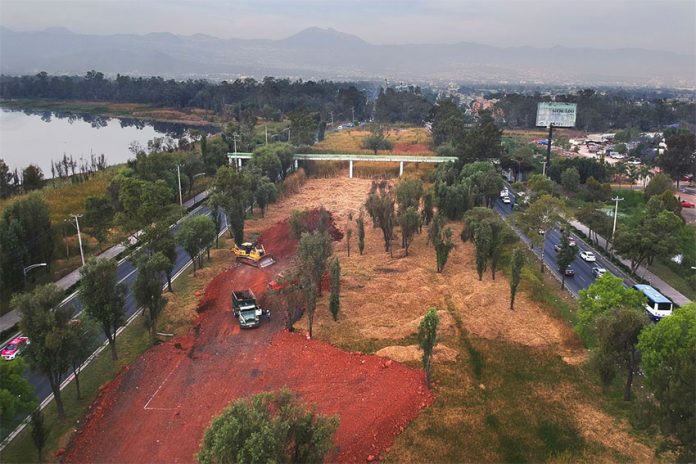A six-lane bridge slated for construction over wetlands in the southern Mexico City borough of Xochimilco is a vital part of an improved road link between the east and south of the capital, says Mayor Claudia Sheinbaum.
But critics of the 680-million-peso (US $30.3-million) project, which began in February, say that it threatens Mexico City’s last – and vitally-important – wetlands, remnants of a vast lake system that once extended across the land now covered by the capital’s urban sprawl.
Now a legal battle is underway to determine whether the government can continue with the bridge project or whether it will be forced to throw its plan into the dustbin of history.
Some context: when Sheinbaum triumphed at Mexico City’s mayoral election in 2018, environmentalists celebrated her victory. They believed that the scientist and former member of the United Nations Intergovernmental Panel on Climate Change would be a champion for the environmental changes the congested and contaminated capital desperately needed.
But three months after she took office in December 2018, the mayor announced a plan that collided head on with that idea: construction of a six-lane bridge that would allegedly destroy at least three hectares of the Xochimilco wetlands.
Its construction and the resultant destruction of the wetlands would be devastating for Mexico City, a National Autonomous University (UNAM) biologist told the newspaper El País.
“Wetlands are fundamental for urban resilience in any city, even more so in a city of this size. They reduce flooding when heavy rains come [and] they’re a temperature buffer,” said Luis Zambrano.
“There is a study that says that if [the] Xochimilco [wetlands] didn’t exist, the average temperature in Mexico City would increase by two degrees [celsius].”
The planned bridge, reported El País, was also proposed by the two previous Mexico City governments but they were unable to execute it because the wetlands are a UNESCO world heritage site, considered internationally important under the Ramsar convention and were designated a Natural Protected Area, or ANP, by the Mexican government almost 30 years ago.
Infrastructure projects are expressly prohibited in ANPs and trees within them are protected. However, the felling of more than 650 trees will be required to build the bridge, El País said.
Zambrano, a fierce defender of the axolotl, a species of salamander endemic to the Xochimilco canals, said that the different national and international “mechanisms should help us to protect” the wetlands but charged that the government doesn’t care about them.

Sheinbaum has claimed that the area where the bridge will be built is not part of an ANP. However that assertion is not backed up by Environment Ministry records.
If the Mexico City government is given a green light, legally speaking, to continue with the bridge project, “everything is at risk” because they will be able to build infrastructure projects wherever they want, Zambrano said.
Authorities in the capital awarded a contract for the bridge’s construction in August 2019 and a month later changed local regulations to allow environmental impact evaluations for all public infrastructure projects to be completed more quickly.
Gaining environmental approval for a large-scale infrastructure project previously involved an exhaustive process that could take months. However, with the modified regulations, authorization for the bridge was granted in just two weeks, El País said.
Mexico City authorities have justified the bridge’s approval on the basis that the area where it will be built was already degraded in the early 1990s when the Periférico ring road was widened and consequently passed over part of the wetlands.
At the time, authorities decided to build a large median strip between the lanes that allowed the wetlands’ water to continue to flow and allowed native animals to move from one side of the wetlands to the other.
However, the bridge project would involve the destruction of the median strip, which environmentalists say would have an adverse impact on the environment and its animals, among which are axolotls, an endemic species of crayfish, the Montezuma frog and more than 400 species of birds.
Academics, activists and environmentalists are also concerned that an almost two-kilometer-long elevated bridge would effectively split the borough of Xochimilco in two.
“It’s a project that will cut off” one half of Xochimilco from the other,” Abril Reza, an activist, told El País during a protest against the bridge. “It will divide [the borough] so we’ve come to stop it,” she said.
“Yes to the wetlands, no to ecocide,” the mostly young demonstrators chanted at a protest in March.
Two months later, residents of several pueblos originarios, or original towns, in Xochimilco, filed an injunction request against the bridge, arguing that its construction would damage an area that is crucial to counteracting the effects of climate change.
The bridge would have an adverse impact on the lives of present and future generations, they said.
A federal judge has agreed to consider the injunction request, El País said, but no decision has yet been made.
Following the publication of the newspaper’s report on Wednesday, Mexico City Environment Minister Marina Robles told a press conference that the bridge project complied with all environmental rules.
She said that most of the wetlands in the area will be maintained and even improved by the project.
Infrastructure Minister Jesús Antonio Esteva Medina explained that most of the wetlands won’t be affected by the bridge because it will be mostly built above existing road.
“We’re very respectful of the environment,” he said, adding that 387 trees will be felled in order to build the bridge but about 1,000 new ones have already been planted in the area.
Source: El País (sp), La Silla Rota (sp)
